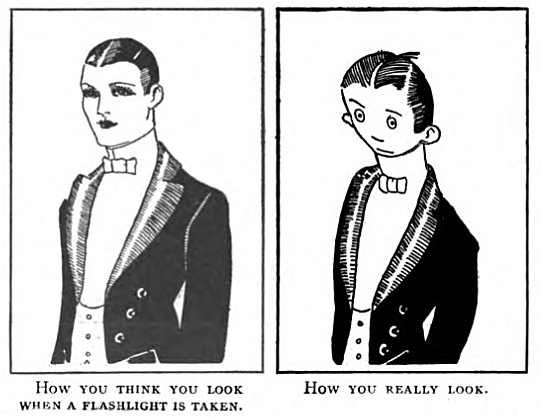Have you ever wondered what was the first meme? According to the BBC, the first meme came from the satirical magazine The Octopus. This was a collegiate magazine from the University of Wisconsin that published between the years 1919 to 1960. It teased the university’s faculty, the administration and the prohibition that was present at the time. The meme in question is one that was published in the June 1920 issue, and it’s titled “Arranging a Date”. It has two pictures. The first one has two men speaking to each other with an image of an elegant woman floating in the background, including a caption that states “As your roommate describes her”. The following picture has one of the men unconscious while the other is fanning him with his hat, and a woman is walking down the stairs. The picture has a caption that states: “As she is”.
Another meme from that magazine that also follows a similar format is one that includes two drawings of a man. The first one has a drawing of an elegant man staring ahead. It has a caption in the bottom that reads “How you look when a flashlight is taken.” The second picture has a man with a shocked expression and a caption that says “How you really look.” This drawing would be published in the Octopus in the May 1921 issue, and then again in the the Judge magazine’s June issue of that same year.
This early meme follows the “expectation vs reality” format. The website Know Your Meme describes it as “a series of images and videos featuring a side-by-side comparison illustrating an obvious discrepancy”. To understand what makes up a meme, the writer Will Fulton for Thrillist has an acronym formed with the letters that make up the word, MEME. The first thing that it needs to have is a message. He explains that a proper meme needs to have a message that is understood by the viewer because it shares a common experience. Then, a meme needs to evolve, it must continue to change in order to reflect a new situation. A meme must also be malleable, meaning that while it must change, it must also retain characteristics of the original meme. The last characteristic is the effect that the meme has, meaning how popular it became, how big of an audience it reached.
Others claim that the Latin phrase, memento mori was the first example of a meme. This phrase translates into English as “Remember you will die”. Despite the very macabre image that the phrase can produce, in art, architecture and literature, it was used more in the line of “life is short, so enjoy it while it lasts”. It can be compared to the recently popular acronym YOLO, which means “You only live once”.
Today, memes have a large focus on how viral they become. This comes along with the belief that if a meme loses popularity online because of the lack of audience, it will disappear. Since virality is such an important factor, it opens the door for people to discuss often heavy topics that are presented in a creative way, breaking down various barriers that might exist in the communication. They can also cross both international and digital boundaries to promote changes that occur at a global scale, showing a greater level of connectivity that exists within the internet. The next time that you see a meme, remember that this is nothing new, and that they serve a dual purpose: to not only entertain us, but to also inform us.



